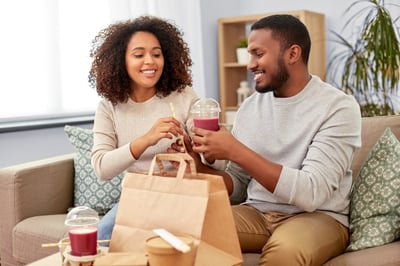Some 54 percent of restaurant operators have temporarily switched to off-premises service only. They face formidable challenges: marketing takeout and delivery options to customers, crafting new menus, and keeping food costs down and quality high, all while operating with a reduced staff. 
Here are tips from chefs and restaurant operators across the country, from fast casual to fine dining, on how to build a takeout and delivery business in challenging times. Hamilton Beach Commercial is here to help operators do more with less.
Make takeout feel like an occasion.
Canlis has been a beloved fine-dining destination in Seattle for nearly 70 years. Now, owner Mark Canlis is continuing to make Canlis a special experience — even when enjoyed at home. “Why not hire the piano players to keep playing?” he thought, and so he livestreams performances from the dining room every weeknight.
The restaurant offers a different family-meal takeout option each night. On Fridays, the restaurant features a dish that’s “a little more celebratory,” Canlis says, such as Dry-Aged Cote de Boeuf for Two, with sides and dessert, for $92 per person. The experience resonates for customers: “But for real... I cried when this arrived,” one posted online with a picture of their meal.
Special meals can be offered at a lower price point, too. When Canlis offered a dry-aged burger with fries for $14, the restaurant sold a thousand in three hours. “It isn’t about profit right now,” Canlis says. “Right now it’s taking care of people.”
Offer variety in family meal bundles.
Instead of a simple main-and-side, make your family takeout meals bigger and more interesting. “Offering a wider selection of items in a bundle can help satisfy everyone around the table and maybe help you avoid a veto vote right now,” says Brooke Brantley, Director of Culinary at McCain Foods, in a recent webinar hosted by Nation’s Restaurant News. For instance, a Latin-inspired bundle could include jalapeno poppers, chips and salsa, rice and beans, and “crispy, spicy, saucy garnishes,” he suggests.
One way to increase variety while avoiding avoid food waste: Make sides in large batches, then use a vacuum chamber sealer to preserve individual portions. Vacuum sealing dramatically extends the shelf life of foods, helping them last 3-5 times longer. Learn more about how vacuum packaging works.
Help families plan ahead.
A major takeout trend — and an effective way to increase order sizes —is combining multiple meals in one order. Kentucky Fried Chicken has expanded its $20 Fill Up® family meal to a $30 version that adds 12 tenders or 8 additional pieces of chicken: “dinner tonight and lunch tomorrow.” Several restaurants in the Chicago-area Lettuce Entertain You Enterprises group offer packages of three family-style meals and sides for $150.
Don’t let the menu get stale.
Gabriel Munoz Becerra, chef at Tarrant’s West in Richmond, Virginia, notices many guests ordering meals three times a week. That means “for the next week, I need to make sure they come back.” He has already distilled Tarrant’s once-enormous menu to a selection of popular entrees, making sure to include both hearty and lighter options: chicken piccata, crab cakes, eggplant parmesan, fish Oscar-style. “You just have to combine what travels well, what do we have, what is most cost-effective for the restaurant and the guest.”
A vacuum chamber sealer helps chefs effectively portion and plan entrees for takeout service, especially when cooked sous vide and held at optimum temperatures. Some of the best choices for sous vide cooking: chicken breast, salmon, leg of lamb, pulled pork, brisket, pork chops, scallops…
Offer add-ons they can’t refuse.
Tarrant’s is famous for its creamy, decadent she-crab soup, which is offered as a standalone order and an upgrade with all family meals ($4-$8 to replace the salad with soup). Around half of guests add the soup to takeout orders, Munoz Becerra says, and on special occasions, like Easter, they sell out.
Appetizers are high-margin additions, Brantley says, such as loaded fries and wings. Restaurateurs also can help customers “fill that vegetable void” in their home diets. If you’re experiencing challenges getting fresh produce from suppliers, use a vacuum sealer to protect and preserve veggies and fruits as soon as they’re delivered. Find out how.
Consider expanding your brand.
Now may not seem like the best time to try new things — but it is, says Aaron Noveshen. He’s the founder of Starbird, a premium chicken restaurant with six locations in the San Francisco area. Noveshen created two new sub-brands, Starbird Salads and Starbird Wings, in order to amplify the company’s presence on third-party delivery sites. It’s working, he said in the NRN webinar; on the very first day he launched Starbird Salads on a single delivery channel, he sold so many he ran out of lettuce. Sales have been rising 10% week over week.
Add cocktail kits (if local law allows)
Restaurants in many states — including Virginia, where Hamilton Beach Commercial is based — have found success selling drinks to go. Canlis sells kits to make the restaurant’s signature “Almost Perfect” cocktail: Stiggin's Fancy Rum, Cochi Americano, Meletti Amaro, and Luxardo Maraschino, plus grenadine, bitters, lemon peel, fresh flower garnish, and even large ice squares. The kit’s $208, and it makes 16 cocktails ($13 per drink). Cheers to a brighter future!

